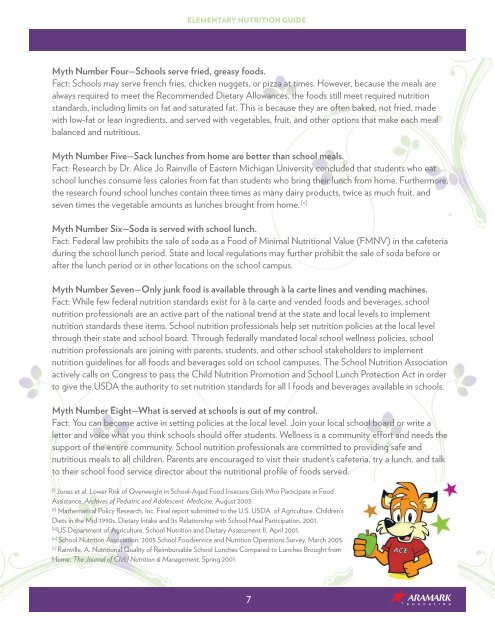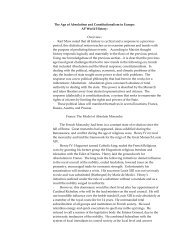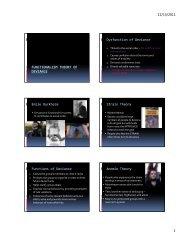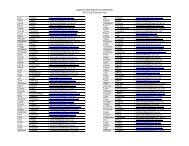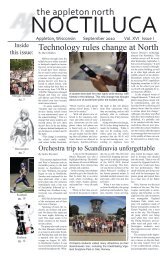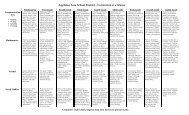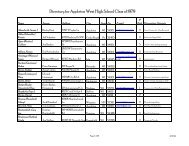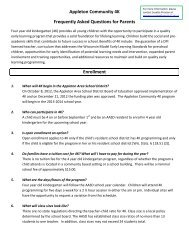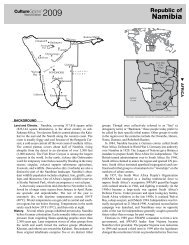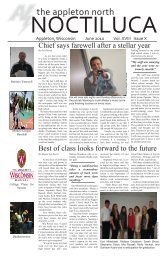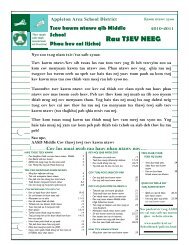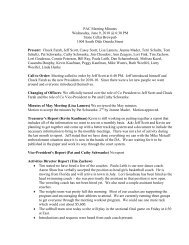Elementary Nutrition Guide for Appleton Area School District
Elementary Nutrition Guide for Appleton Area School District
Elementary Nutrition Guide for Appleton Area School District
You also want an ePaper? Increase the reach of your titles
YUMPU automatically turns print PDFs into web optimized ePapers that Google loves.
ELEMENTARY NUTRITION GUIDE<br />
Myth Number Four—<strong>School</strong>s serve fried, greasy foods.<br />
Fact: <strong>School</strong>s may serve french fries, chicken nuggets, or pizza at times. However, because the meals are<br />
always required to meet the Recommended Dietary Allowances, the foods still meet required nutrition<br />
standards, including limits on fat and saturated fat. This is because they are often baked, not fried, made<br />
with low-fat or lean ingredients, and served with vegetables, fruit, and other options that make each meal<br />
balanced and nutritious.<br />
Myth Number Five—Sack lunches from home are better than school meals.<br />
Fact: Research by Dr. Alice Jo Rainville of Eastern Michigan University concluded that students who eat<br />
school lunches consume less calories from fat than students who bring their lunch from home. Furthermore,<br />
the research found school lunches contain three times as many dairy products, twice as much fruit, and<br />
seven times the vegetable amounts as lunches brought from home. [v]<br />
Myth Number Six—Soda is served with school lunch.<br />
Fact: Federal law prohibits the sale of soda as a Food of Minimal <strong>Nutrition</strong>al Value (FMNV) in the cafeteria<br />
during the school lunch period. State and local regulations may further prohibit the sale of soda be<strong>for</strong>e or<br />
after the lunch period or in other locations on the school campus.<br />
Myth Number Seven—Only junk food is available through à la carte lines and vending machines.<br />
Fact: While few federal nutrition standards exist <strong>for</strong> à la carte and vended foods and beverages, school<br />
nutrition professionals are an active part of the national trend at the state and local levels to implement<br />
nutrition standards these items. <strong>School</strong> nutrition professionals help set nutrition policies at the local level<br />
through their state and school board. Through federally mandated local school wellness policies, school<br />
nutrition professionals are joining with parents, students, and other school stakeholders to implement<br />
nutrition guidelines <strong>for</strong> all foods and beverages sold on school campuses. The <strong>School</strong> <strong>Nutrition</strong> Association<br />
actively calls on Congress to pass the Child <strong>Nutrition</strong> Promotion and <strong>School</strong> Lunch Protection Act in order<br />
to give the USDA the authority to set nutrition standards <strong>for</strong> all I foods and beverages available in schools.<br />
Myth Number Eight—What is served at schools is out of my control.<br />
Fact: You can become active in setting policies at the local level. Join your local school board or write a<br />
letter and voice what you think schools should offer students. Wellness is a community ef<strong>for</strong>t and needs the<br />
support of the entire community. <strong>School</strong> nutrition professionals are committed to providing safe and<br />
nutritious meals to all children. Parents are encouraged to visit their student’s cafeteria, try a lunch, and talk<br />
to their school food service director about the nutritional profile of foods served.<br />
[i] Jones et al. Lower Risk of Overweight in <strong>School</strong>-Aged Food Insecure Girls Who Participate in Food<br />
Assistance, Archives of Pediatric and Adolescent Medicine, August 2003.<br />
[ii] Mathematical Policy Research, Inc. Final report submitted to the U.S. USDA of Agriculture. Children’s<br />
Diets in the Mid-1990s. Dietary Intake and Its Relationship with <strong>School</strong> Meal Participation. 2001.<br />
[iii] US Department of Agriculture. <strong>School</strong> <strong>Nutrition</strong> and Dietary Assessment II, April 2001.<br />
[iv] <strong>School</strong> <strong>Nutrition</strong> Association, 2005 <strong>School</strong> Foodservice and <strong>Nutrition</strong> Operations Survey, March 2005.<br />
[v] Rainville, A. <strong>Nutrition</strong>al Quality of Reimbursable <strong>School</strong> Lunches Compared to Lunches Brought from<br />
Home, The Journal of Child <strong>Nutrition</strong> & Management, Spring 2001.<br />
7


